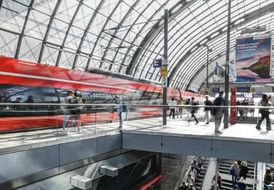Management approach and noise Reduction target
Further reducing the impacts of rail transport noise on local residents is an essential prerequisite for the further shift in the mode of transport towards rail. We are therefore continuing to work on implementing our noise reduction target:
- In continuing the Federal Government’s noise remediation program, between 1999 and 2030, we will reduce rail transport noise on a total of 3,250 km of existing lines with around 800,000 residents. This corresponds to half of those affected. By 2020, we had already reached around 2,000 km. By 2030, an additional approximately 1,250 km of existing lines will be included.
- By 2050, we will have alleviated rail transport noise for all residents living near existing lines affected by rail transport noise. A prerequisite for achieving these targets is the adequate provision of funds for local noise remediation measures by the Federal Government in the noise reduction item of the Federal budget.
By implementing our two-pillar noise reduction strategy, which focuses firstly on on-site measures (infrastructure) and secondly on at-source measures (vehicles), we are improving public acceptance of the shift in the mode of transport towards rail.
- Since 2020, DB Cargo freight cars have been fully converted to quiet brakes. By 2025, our electric track locomotives on DB Cargo freight trains in Germany will also be running with quiet brake systems.
- By 2030, DB Cargo will retire the 232/233 series diesel locomotives. Only class 77 series locomotives with less than 2% of DB Cargo train runs will still use gray cast iron block brakes.
- DB Long-Distance will replace all diesel-powered shunting locomotives with particularly quiet and climate-friendly hybrid shunting locomotives by 2025. Noise protection therefore simultaneously contributes to climate protection aims.
The innovative noise remediation project I-LENA enabled the manufacturers of noise protection technologies to have their innovations tested for acoustic effectiveness in real operations on test lines. The final report on I-LENA was published online.
Together with the German Center for Rail Traffic Research (Deutsches Zentrum für Schienenverkehrsforschung; DZSF) and our industry partners, we aim to continue advancing research and development in noise remediation measures for track infrastructure and vehicles so that we can implement more effective noise remediation measures.


